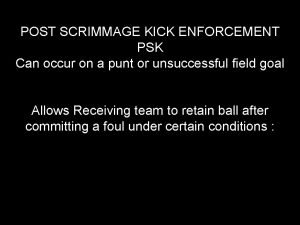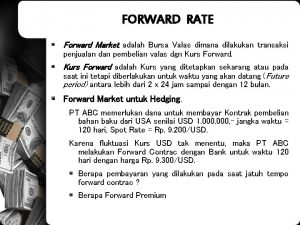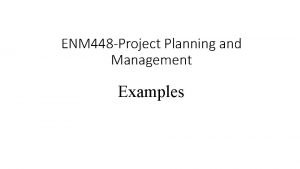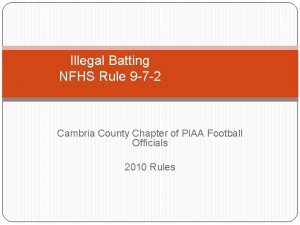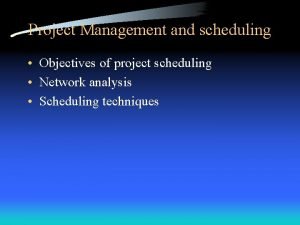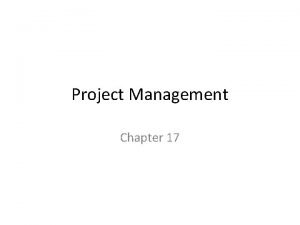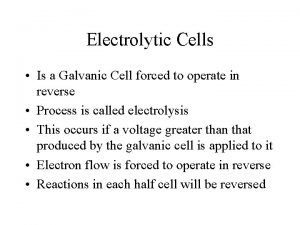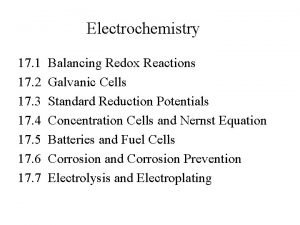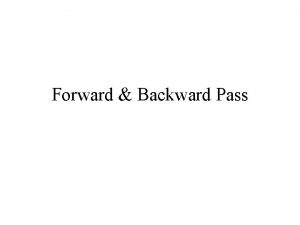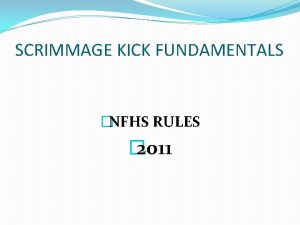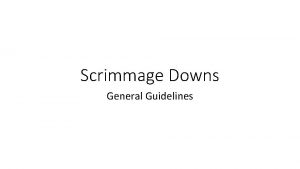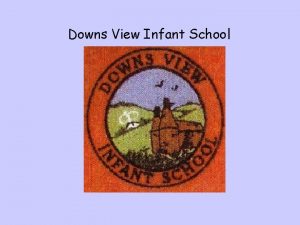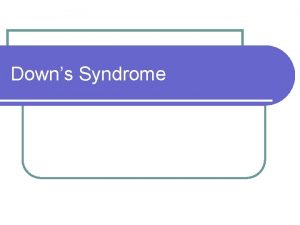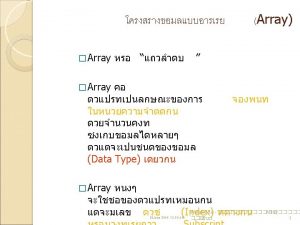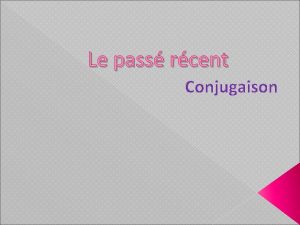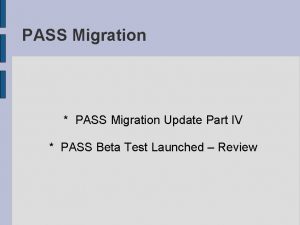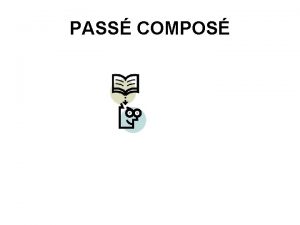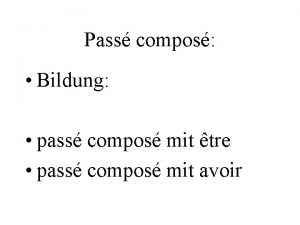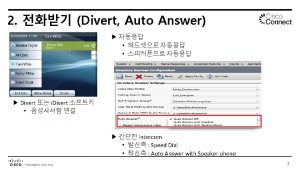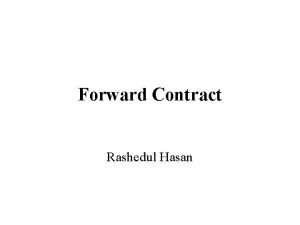Scrimmage Downs Keys Run Plays Pass Plays Forward




















- Slides: 20

Scrimmage Downs Keys; Run Plays; Pass Plays Forward Progress

Determining Keys • Receivers are numbered from each sideline. Widest is #1; next is #2; etc. If receivers are stacked, closest to LOS is lower number. • In general, H & L will have #1; B will have #2. If only 1 receiver to each side, B will have #1 to L’s side and L will observe backs coming out of backfield. • TWINS: H & L will have #1 to their side; B will have #2 to L’s side (primary) and then the receiver from H’s side that enters middle zone (secondary). • TRIPS: H & L will have #1 to their side; B will have #3. The #2 receiver is assigned based on to whom he is closer. Closer to #1 → H or L; Closer to #3 → B • QUADS: Wing & Back Judge take 2 receivers closest to them; Watch for Press Coverage; Switch to “Areas of Responsibility” quickly. • MOTION: May or may not affect keys; “Snapshot” of positions at the snap will determine keys.

Balanced Formation (1 Receiver Each Side) • Strength declared to L’s side • H has #1 receiver on H’s side H • B has receiver on L’s side • L has backs leaving backfield B L

` ` ` ` ` Strength to H’s Side H • H has #1 receiver on H’s side • B has #2 receiver on H’s side • L has #1 receiver on L’s side B L

Strength to L’s Side H • L has #1 receiver to L’s side. • B has #2 receiver to L’s side • H has #1 receiver on H’s side B L

Twins (2 Receivers to Each Side) H B L • Strength declared to L’s side • H has #1 receiver to H’s side • L has #1 receiver to L’s side • B’s primary key is #2 receiver to L’s side. • B’s secondary key is receiver (#1 or #2) entering middle zone from H’s side.

Trips (3 Receivers to One Side) H B L • H has #1 receiver to H’s side • L has #1 receiver to L’s side • B has #3 receiver • #2 receiver assigned by to whom he is closer - #1 or #3 • Be prepared to go to Zone coverage quickly

Quads (4 Receivers to One Side) H B • H has #1 receiver to H’s side • L has two receivers closest to L (#1 & #2) Watch Press Coverage • B has two receivers closest to B (#3 & #4) • Switch to “Areas of Responsibility” quickly. (Man – Zone – Ball) L

Running Plays Initial Responsibilities

Referee • Observe action behind LOS and the runner to the NZ. Trail (don’t chase) runner into side zone, covering behind play. • Observe action on the ball and QB on handoffs & backward passes. • Once you read run, focus on front side of point of attack (POA). • Stay with QB when: he goes OB; after handoffs & backward passes; and after change of possession (COP). • Assist with ball mechanics/spotting the ball.

Umpire • On plays between tackles, focus on POA in front of & around runner. • On plays outside tackles, turn slowly toward flow, clearing blockers as you turn. Observe action on the back side of flow (behind & away from runner). • For dead ball between hash marks, retrieve & spot ball according to forward progress marked by wing AND closest lateral placement (1 -5). • For dead ball outside hash marks, initiate ball mechanics to spot ball as stated above. • For wide plays and OB, be prepared to assist with separating players. “Follow the Hogs”

Wings (H and L) • Observe action on and by your key, especially if pressed. • Observe blocking in front of runner who is behind LOS on your side or in the NZ. • Determine forward progress when necessary. (Cross-field Mechanics) • Cover runner in your side zone to the GL, observing action on and by the runner. If OB, may face out in order to observe players. • Flow away, clean up action behind play.

Back Judge • Observe action on and by your key(s), especially if pressed. • Move laterally and backward to observe actions of players ahead of the runner as ball moves toward sideline. Assist umpire with second level blocking. • For wide plays and OB, be prepared to assist with separating players and with ball mechanics. • Be ready to take over on cutback and breakaway plays. On long plays, be ready to rule on the goal line.

Goal Line Plays • R: Same position & coverage as other scrimmage plays. • U: Same position & coverage as other scrimmage plays. Don’t stand on GL. Watch for ball being moved forward after declared dead. Never signal score, but assist wing with ball location, if necessary. • H/L: Initial position wide, off sideline. Cover GL at snap to rule on score. Work back forward progress if short of GL. Watch for pass. • B: Not as deep as normal. Sole coverage of end line. Coordinate coverage with wing on passes (catch/feet). Maintain wide view for fouls.

Forward Passes Basic Coverage

Referee • Observe legality of blocks in backfield and by your line key until QB is threatened. • Observe legality of pass and action by and against the passer. • Verbally alert defenders when pass has been released. (Ball’s away) • Continue to observe passer until no longer threat of foul. • Determine forward/backward pass with help of wing • R is solely responsible for RPS & ING (may get help from wings)

Umpire • Check legality of numbers of interior linemen. • Observe actions of players on and directly behind NZ (HIPI fouls). • Observe OL for potential IDP. • Pivot on low trajectory and short passes over middle to assist with catch/no catch. • Signal legal touching (tip) when appropriate.

Wings • Observe action by and on eligible receivers (keys). • Rule of forward/backward of quick passes. Covering official signals if backward (arm extended horizontally toward passer’s GL) • Move downfield 5 -7 yards. • When pass in flight, move to best position to judge the play. • Be prepared for cross-field mechanics when receiver on opposite side is driven backward after catch. • Be prepared to come back to NZ if necessary. • Entire sideline is your responsibility (Catch; Runner OB)

Back Judge • Observe action on and by keys as they leave LOS. • Cover plays from behind deepest receivers. • Transition to Zone Coverage after receivers are free from threat at LOS • Bracket receivers between yourself and the appropriate wing. • Observe contact between receiver and defensive player: Earn your $$ • DH • DPI • OPI

 Miracle and morality play
Miracle and morality play Forward pass and backward pass
Forward pass and backward pass Scrimmage kick
Scrimmage kick Elijah kirtland temple
Elijah kirtland temple Key of content writing
Key of content writing Forward market adalah
Forward market adalah Forward rate adalah
Forward rate adalah Forward pass definition project management
Forward pass definition project management Illegal batting high school football
Illegal batting high school football Forward pass scheduling
Forward pass scheduling Poma software engineering
Poma software engineering Forward pass
Forward pass Vsu centennial hall
Vsu centennial hall Proceso downs sodio
Proceso downs sodio Glucose ups and downs
Glucose ups and downs Downs cell
Downs cell Electroplating khan academy
Electroplating khan academy North downs benefice
North downs benefice Incurved fifth finger
Incurved fifth finger Redox reactions examples
Redox reactions examples Rick downs
Rick downs


